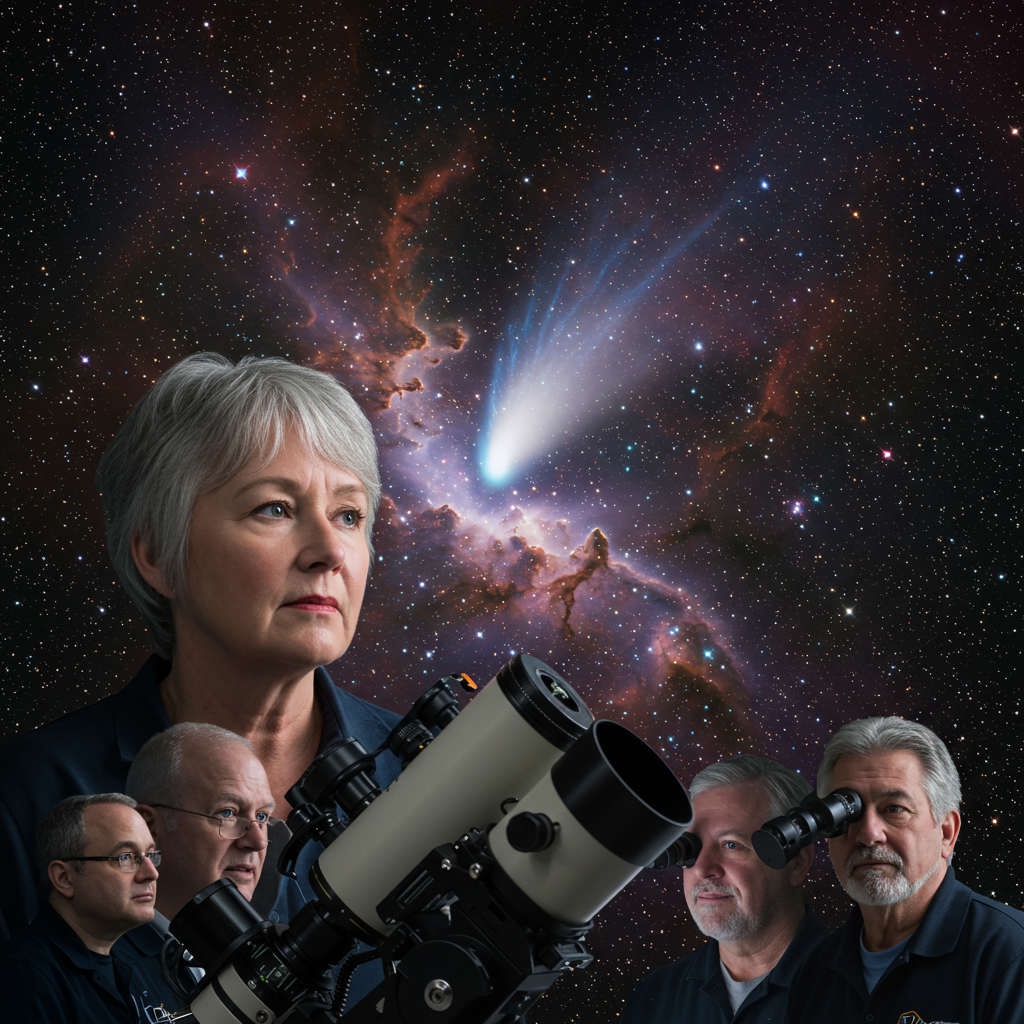The recent detection of a mysterious cosmic traveler has ignited excitement among astronomers worldwide. Named 3I/Atlas, this object isn’t just passing through; scientists believe it could be the most ancient comet ever witnessed by humanity. Hailing from beyond our familiar stellar neighborhood, its arrival marks a rare opportunity to study material potentially billions of years older than our sun and planets. Preliminary findings suggest an object that predates our solar system by a significant margin, offering unprecedented insights into the distant, early history of our Milky Way galaxy.
A Rare Visitor from Interstellar Space
Space is vast, and most objects we observe reside within our solar system. Occasionally, however, a rogue wanderer zooms in from the void between the stars. 3I/Atlas is one such extraordinary visitor. Identified on July 1, 2025, by the ATLAS survey telescope located in Río Hurtado, Chile, it was initially spotted roughly 670 million kilometers from our sun.
This is only the third confirmed object known to have originated from outside our solar system, making each discovery highly significant. The previous two interstellar guests were 1I/’Oumuamua, found in 2017, and 2I/Borisov, detected in 2019. Unlike its predecessors, early observations indicate 3I/Atlas might be larger and is already exhibiting clear cometary activity.
When viewed through large telescopes, it presents a ‘fuzzy’ appearance, confirming the presence of a coma (an atmosphere of gas and dust) and a short tail. This characteristic fuzzy look and tail definitively classify it as a comet. Its rapid speed, exceeding 60 kilometers per second (over 134,000 mph), further underscores its non-solar system origin, as objects bound to our sun typically move slower at similar distances.
Unlocking the Age of the Galaxy’s Thick Disk
What truly sets 3I/Atlas apart is its potential age. According to a team led by researchers at the University of Oxford, this interstellar comet could be astonishingly ancient. Estimates place its age at more than seven billion years old, potentially predating our own solar system by over three billion years. Our solar system is approximately 4.5 billion years old, meaning 3I/Atlas could be nearly twice its age.
The scientists propose that 3I/Atlas originated in a specific, ancient region of the Milky Way known as the ‘thick disk.’ This galactic component consists of older stars orbiting on a steep, inclined path above and below the thinner disk where our sun and most younger stars reside. Material from this ancient stellar population has never before made a flyby of Earth, offering a unique chance to study it up close.
Professor Chris Lintott, a co-author of the study, highlighted the excitement. He noted this object comes from a part of the galaxy we haven’t seen physically before. This unique trajectory from the thick disk is a key distinguishing feature compared to ‘Oumuamua and Borisov.
How Do We Know It’s So Old?
The extraordinary age estimate isn’t based purely on speculation. The Oxford team utilized a sophisticated statistical model, known as the ‘Ōtautahi-Oxford Model, developed during the PhD research of astronomer Matthew Hopkins. This model analyzes the object’s speed, trajectory, and likely stellar origin to infer its age.
Based on this model, researchers estimate a significant probability—nearly 70%—that 3I/Atlas is between 7.6 and 14 billion years old. Professor Lintott specifically stated there’s about a two-thirds chance the comet is older than the solar system itself. This stands in stark contrast to comets that formed within our solar system, which are inherently no older than 4.5 billion years.
By studying 3I/Atlas, scientists can test these predictive models in real-time. The composition of gases it releases as it approaches the sun will be critical for verifying the model’s predictions about objects formed around ancient thick-disk stars.
The Icy Composition and Future Spectacle
Scientists theorize that because 3I/Atlas likely formed around an old star within the thick disk, its composition should be rich in water ice. Early observations supporting its cometary nature align with this prediction, showing clear signs of outgassing.
As 3I/Atlas continues its journey toward the sun, currently located at roughly Jupiter’s distance from Earth, solar energy will increasingly heat its icy surface. This heating process causes the ice to sublimate directly into gas, releasing dust trapped within the nucleus. This activity creates the glowing coma and the characteristic tail that defines a comet’s appearance.
Currently, only very large telescopes are capable of observing 3I/Atlas. However, astronomers anticipate it will brighten considerably. Projections suggest that by late 2025 or early 2026, it could become visible even through reasonably sized amateur telescopes. Its closest approach to the sun is expected in October 2025, though it will remain safely over 240 million kilometers away from Earth – well outside the orbit of Mars. This distant pass ensures the comet poses absolutely no threat to our planet.
Why 3I/Atlas Matters to Science
The discovery of 3I/Atlas represents a profound opportunity for astrophysics. Studying its composition and behavior offers a unique window into a previously inaccessible part of our galaxy. It’s like receiving a sample from an ancient, distant region without having to travel there.
Analyzing the gases and dust shed by the comet can provide unprecedented insights into the chemistry of ancient star systems within the Milky Way’s thick disk. This, in turn, can shed light on the conditions prevalent during the early epochs of star and planet formation across the galaxy. It could help scientists understand how planetary building blocks, like water ice, might have formed and been distributed in very old systems. The data gathered will be crucial for testing and refining current astrophysical models that describe stellar populations and the formation of planetary systems.
Scientists like Michele Bannister note that the observed activity and released gases are already providing valuable data to test their predictions. The potential to examine material linked directly to the stellar populations of the ancient thick disk makes 3I/Atlas perhaps the most remarkable interstellar visitor yet observed.
The Future of Interstellar Discoveries
The detection of 3I/Atlas is timely, coinciding with advancements in astronomical observation technology. Astronomers are eagerly anticipating the full operation of powerful new telescopes, such as the Vera C. Rubin Observatory in Chile, later this year.
The ‘Ōtautahi-Oxford Model that helped characterize 3I/Atlas had already predicted that new telescopes like the Rubin Observatory could drastically increase the rate of interstellar object discoveries, estimating between five and fifty new objects per year. The discovery of 3I/Atlas, potentially larger than its interstellar predecessors, makes these predictions even more optimistic. The possibility of regularly detecting and studying multiple interstellar objects annually opens up entirely new avenues for understanding galactic dynamics, chemistry, and the prevalence of planetary systems elsewhere in the universe.
The excitement surrounding 3I/Atlas underscores a pivotal moment in astronomy. Its potential as the oldest comet ever seen provides a tangible link to the deep past of our galaxy and promises to rewrite our understanding of cosmic history.
Frequently Asked Questions
How old is the interstellar object 3I/Atlas estimated to be?
Scientists estimate that the interstellar object 3I/Atlas could be incredibly old, potentially exceeding seven billion years. This age is significantly greater than our solar system, which is about 4.5 billion years old. Using a sophisticated model, researchers suggest there is a high probability (around 70%) that 3I/Atlas falls within the age range of 7.6 to 14 billion years, potentially making it the oldest comet ever observed and substantially older than any comet formed within our own solar system.
Where did the interstellar comet 3I/Atlas likely originate?
Astronomers believe that the interstellar comet 3I/Atlas originated from the Milky Way’s ‘thick disk.’ This is an ancient region of the galaxy characterized by older stars that orbit on a different, steeper path compared to the thin disk where our sun is located. This origin is unique among the three detected interstellar objects so far (‘Oumuamua, Borisov, 3I/Atlas) and offers a rare opportunity to study material from this specific, ancient part of the galaxy.
Can amateur astronomers see the 3I/Atlas comet?
Currently, the interstellar comet 3I/Atlas is only visible using very large, powerful telescopes due to its distance and faintness. However, as it continues its approach towards the sun later this year, astronomers expect it to brighten. Predictions suggest that by late 2025 or early 2026, it may become bright enough to be observable from Earth using reasonably sized amateur telescopes, offering a unique viewing opportunity for stargazers.
Conclusion
The detection of 3I/Atlas is far more than just spotting another object in the night sky. This potential ancient interstellar comet, possibly billions of years older than our sun, represents a tangible piece of the Milky Way’s deep past. Its likely origin from the galaxy’s thick disk opens a unique window into conditions present during the formation of ancient star systems. As astronomers continue to track its path and analyze the data it yields, 3I/Atlas is set to provide invaluable insights, testing astrophysical models and enhancing our understanding of cosmic history. The prospect of more such interstellar visitors being discovered with the advent of new, powerful telescopes promises an exciting future for astronomy.




